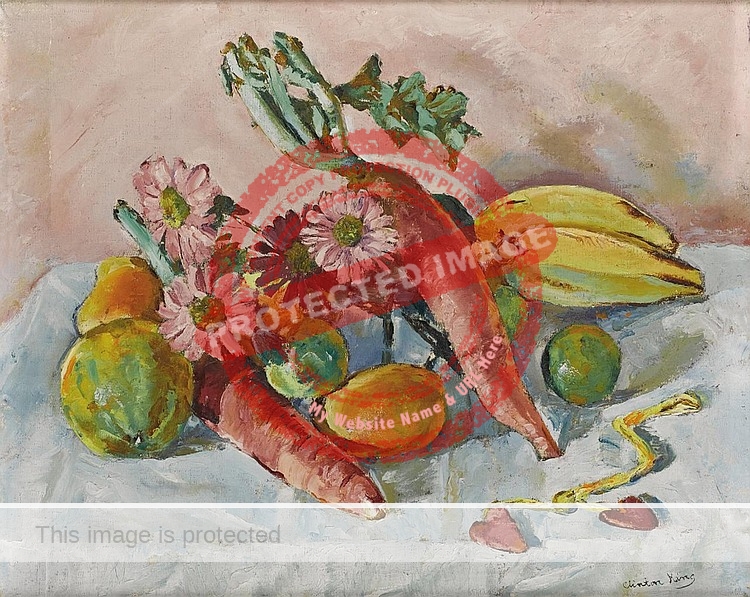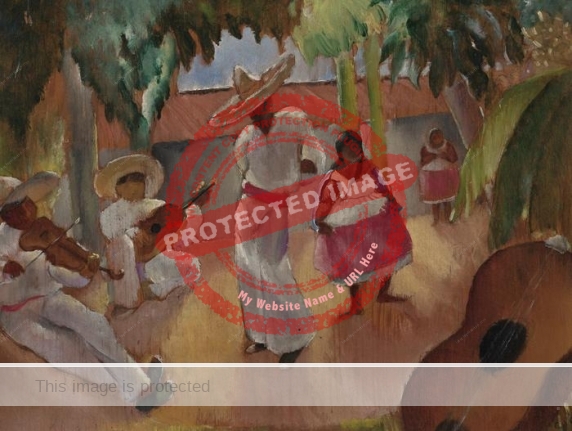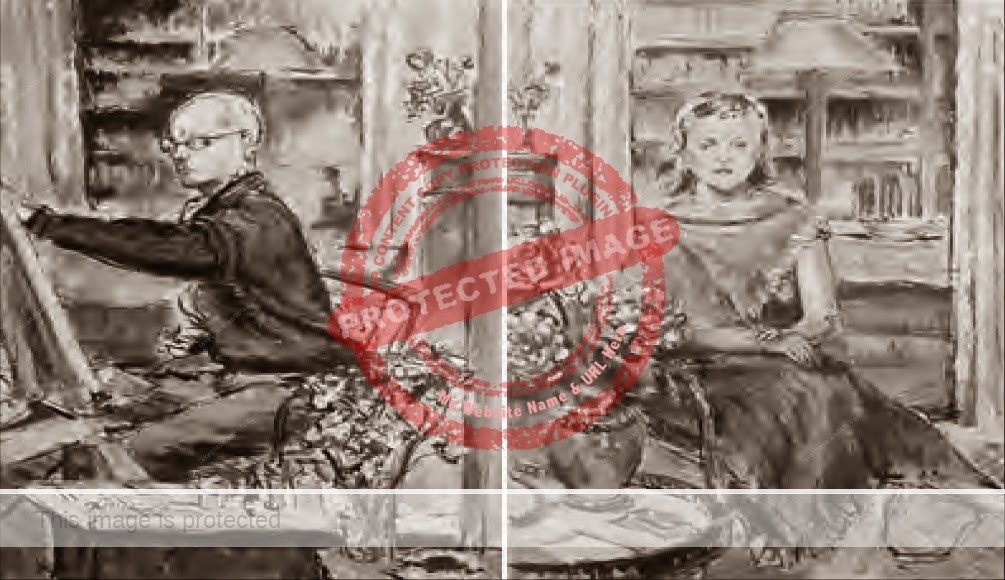Clinton Blair King (1901-1979) and his wife – Lady Duff Twysden (1892-1938) – lived in Chapala for about three years in the early 1930s. (Twysden was immortalized by Ernest Hemingway as the character Lady Brett Ashley in his first major novel, The Sun Also Rises.)
King first met Twysden in Paris in 1927. Born in Texas, he was nine years her junior and heir to his family’s candy company fortune. Shortly after they met, Twysden moved in to live with King at his studio. They married secretly in London, England, in August 1928. King’s family disapproved and King lost both his allowance and his inheritance.

Clinton King. 1930s. Still life. (Sold at Heritage Auctions, 2006)
After Paris, the couple lived briefly in New Mexico before opting to move to Mexico in about 1930. They lived in Mexico for the next three years, mainly at Lake Chapala but also for a short time in Pátzcuaro.
King was born in Fort Worth, Texas, in 1901 and studied at the Virginia Military Institute, the University of Texas and Princeton University. He also attended the Grand Central School of Art, the National Academy of Design in New York and Broadmoor Art Academy. His art teachers included Sallie Blythe Mummert, Charles Webster Hawthorne, Robert Reid and Randall Davey. Over his 40-year artistic career, King mastered several distinct styles including Realism, Impressionism and Abstract Expressionism at different times. He was also a talented pianist.
King first gained recognition in the art work when his oil portrait of “Spud” Johnson (who had just returned from visiting Chapala with D. H. Lawrence and Witter Bynner) was exhibited at the Annual Exhibition of the Society of Independent Artists in New York (1926-27); the portrait was praised by critics.
After moving to Mexico, King developed his talent for portraiture and his early modernist portraits have been favorably compared by critics to those by Diego Rivera.

Clinton King. 1933. The Jarabe. (Credit: The Owings Gallery)
Author Bernice Kert quotes King as describing his time in Chapala as more purposeful than his life in Paris: “We lived a different life from the rather senseless Montparnasse days. I worked all day at painting while Duff drew her amusing sketches in watercolor, or posed for me, or read a great deal.” The Kings became good friends with economist-author Stuart Chase and his wife who visited Lake Chapala for a vacation.
The great American poet Witter Bynner, a long time resident of Chapala, knew the Kings well and his double sonnet about them, entitled “Expatriates”, was published in Guest Book (1935), his collection of masterful sonnets about his friends and acquaintances.
King held his first solo show at the State Museum in Guadalajara in 1933. Reviewing that exhibition, Oto Lear, a Guadalajara art critic, said that all the paintings were completed during King’s time in Chapala where he had been living for the past three years. Lear summed up King as a “practical dreamer who had adapted to modern times without abandoning the idealism of great works.”
Lear was especially impressed by King’s portraits which included a “psychological study” of Carol Navarro, a classical portrait of Maria Pacheco (widow of hotelier Ignacio Arzapalo) and a study of “his wife, Duff King” who so inspires her husband. There were several portraits of the “native inhabitants of Chapala” as well. More abstract works included some colorful “regional cubists” of Chapala. King also exhibited several “vernacular, colorful watercolors.” His oil paintings almost certainly included one entitled “Roofs of Chapala,” a photograph of which was later chosen for inclusion in a 1939 issue of Mexican Life, Mexico’s Monthly Review.
In summer 1933, the Kings left Mexico for New York, before settling in Santa Fe, New Mexico, where Twysden died of tuberculosis on 27 June 1938.
King remained in New Mexico and was later introduced to Narcissa Swift (1911-1998), heiress to the eponymous meat-packing company, by mutual friends, Georgia O’Keeffe and Mabel Dodge Luhan. In 1941, Swift became King’s second wife. They divided their time between Chicago, Paris and Mexico (where they owned a home in Taxco, Guerrero). O’Keeffe’s painting “Narcissa’s Last Orchid” (1941) was a tribute to Swift. (O’Keeffe has her own vicarious connection to Lake Chapala via sculptor Mym Tuma, who had a studio in San Pedro Tesistan, near Jocotepec, from 1968 to 1973)).

Clinton King and Narcissa Swift King – self portrait.
In 1950, King and his wife joined Witter Bynner and his partner Bob Hunt on a six month trip to Europe and North Africa, visiting (among others) Thornton Wilder and James Baldwin in Paris, and George Santayana and Sybille Bedford (author of a travelogue-novel about Lake Chapala) in Rome.
King was one of the most prominent of all early Texas artists. His work was widely exhibited in Europe and North America. According to one biography, his solo shows included Guadalajara Regional Museum (1933); Galeria Excelsior in Mexico City (1933); Witte Memorial Museum, San Antonio (1934 and 1955); Passadoit Gallery, New York (1935); Fort Worth Artists Guild (1937); North Texas State Teachers College in Denton (1937); Elisabet Ney Museum in Austin (1938); Dallas Museum of Fine Arts (1939); Alice Roullier Art Galleries, Chicago (1941); Corpus Christi Memorial Museum (1947); Feragil Art Galleries, New York (1949, 1950); Elizabeth Nelson Galleries, Chicago (1951, 1953); Fairweather-Hardin Gallery, Chicago (1958); William Findlay Gallery, Chicago (1964, 1965); and Chicago Public Library (1966) as well as seven one-person shows elsewhere (London, Paris, Stockholm, Lisbon and Casablanca).
The 1937 exhibition at the North Texas Teachers College was a selection of watercolors and drawings, mostly produced in Mexico. It included several portrait studies, for which King was particularly well known, and a number of landscapes painted in Taxco and Cuernavaca.
Among the many public collections that hold paintings by King are those of the the Biblioteque Nationale in Paris; the Victoria and Albert Museum, London; the Library of Congress; the National Collection of Fine Art, Washington D.C.; the New York Public Library; the Museum of Fine Arts, Santa Fe; the Philadelphia Museum of Fine Art; the Modern Art Museum in Fort Worth; California Palace of the Legion of Honor, San Francisco; the Indianapolis Museum of Art; and Baltimore Museum of Art.
King died while on vacation in Cuernavaca in 1979. In the mid-1980s, two retrospective exhibitions were held in Santa Fe: at the Armory for the Arts (1985) and Fogelson Library Center, College of Santa Fe (1986).
Sources
- Witter Bynner. 1935. Guest Book. New York: Alfred A. Knopf.
- Peter Falk, editor. Who Was Who in American Art. Sound View Press, 1985.
- El Informador, 11 May 1930, 8; 18 March 1933, 5; 19 March 1933, 4.
- Bernice Kert, 1983. Hemingway’s women. W.W. Norton & Co.
- John and Deborah Powers, Editors. Texas Painters, Sculptors & Graphic Artists: A Biographical Dictionary of Artists in Texas before 1942. Woodmont Books, 2000.
Comments, corrections or additional material related to any of the writers and artists featured in our series of mini-bios are welcomed. Please use the comments feature at the bottom of individual posts, or email us.
Tony Burton’s books include “Lake Chapala: A Postcard History” (2022), “Foreign Footprints in Ajijic” (2022), “If Walls Could Talk: Chapala’s historic buildings and their former occupants” (2020), (available in translation as “Si Las Paredes Hablaran”), “Mexican Kaleidoscope” (2016), and “Lake Chapala Through the Ages” (2008).
The self portrait pictured above is Clinton King and his first wife, Lady Duff Twysden, not Narcissa. Lady Duff lived to 1938. Marriage to 2nd wife Narcissa was 11th April 1941.
According to the best available research on this question, there is little doubt that the portrait does actually show Narcissa Swift King – please see http://www.oakhurstfw.org/2014/01/oakhurst-developers-family-had-links-to.html for details.
To whom it may concern: I have in my possession a painting of narcissa Swift King along with a couple of more prints from Clinton King
Hi Dennis, Thanks for getting in touch and congratulations on being the proud owner of a painting by NSK and some prints from CK. I’d love to see images of the works if you are wiling to share them, please, preferably as attachments sent via email to this email. Keep well, TB.
I am very interested in possibly purchasing any portraits of Narcissa Swift King. Thank you. Jgromacki@jenner.com